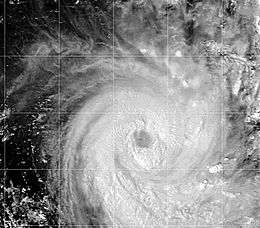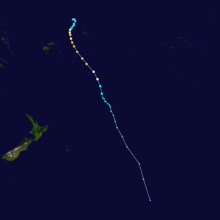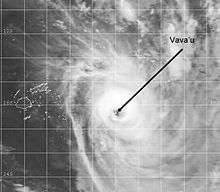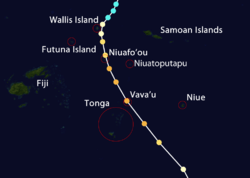Cyclone Waka
| Category 4 severe tropical cyclone (Aus scale) | |
|---|---|
| Category 3 (Saffir–Simpson scale) | |
 Cyclone Waka near peak intensity shortly before moving through Tonga | |
| Formed | December 19, 2001 |
| Dissipated | January 2, 2002 |
| Highest winds |
10-minute sustained: 185 km/h (115 mph) 1-minute sustained: 185 km/h (115 mph) Gusts: 250 km/h (155 mph) |
| Lowest pressure | 930 hPa (mbar); 27.46 inHg |
| Fatalities | 1 indirect |
| Damage | $51.4 million (2002 USD) |
| Areas affected | Wallis and Futuna, Niue, Tonga; especially Vava'u, and New Zealand |
| Part of the 2001–02 South Pacific cyclone season | |
Severe Tropical Cyclone Waka (Fiji Meteorological Service designation: 03F, Joint Typhoon Warning Center designation: 07P) was one of the most destructive tropical cyclones ever to affect the South Pacific Kingdom of Tonga. Waka originated within the near-equatorial trough in mid-December 2001, although the system remained disorganized for more than a week. The storm gradually matured and attained tropical cyclone status on December 29. Subsequently, Waka underwent rapid intensification in which it attained its peak intensity as a Category 4 severe tropical cyclone (Australian tropical cyclone intensity scale) on December 31, with winds of 185 km/h (115 mph). Shortly thereafter, it passed directly over Vavaʻu, Tonga, resulting in widespread damage. By January 1, 2002, the cyclone began to weaken as it underwent an extratropical transition. The remnants of Waka persisted for several more days and were last observed near the Southern Ocean on January 6.
Although the storm affected several countries along its path, Waka left the most significant losses in Tonga, where it killed one person and wrought 104.2 million paʻanga ($51.3 million USD) in damage. Hundreds of structures, including 200 in the island's largest city, and much of the nation's agriculture were destroyed. Winds in excess of 185 km/h (115 mph) battered Vava'u, defoliating nearly every tree on the island. In addition to infrastructural and public losses, the environment was also severely affected; a native species of bat lost roughly 80% of its population due to the lack of fruit. Following the storm, Tonga requested international aid to cope with the scale of damage. Due to the severity of damage, the name Waka was later retired and replaced with Wiki. According to a study by Janet Franklin et al., storms similar in intensity to Waka, on average, strike Tonga once every 33 years.[1]
Meteorological history

In mid-December 2001, at the end of a Madden–Julian oscillation pulse, twin equatorial monsoonal troughs developed in the Northern and Southern Hemispheres. Although warm sea surface temperatures of 30 °C (86 °F) in the region favored development of a tropical cyclone, the southern trough developed substantially slower than the northern one.[2] On December 19, the southern component was classified as Tropical Depression 03F by the Regional Specialized Meteorological Center in Nadi, Fiji (Fiji Meteorological Service); at this time the depression was situated just east of the Solomon Islands.[3] The northern component eventually developed into Typhoon Faxai, an extremely powerful Category 5 equivalent cyclone.[4] Unlike Faxai, the precursor to Cyclone Waka developed slowly, mainly because of moderate wind shear in the region. Moving southeastward, the system gradually became more organized.[2] On two occasions, the Joint Typhoon Warning Center (JTWC) issued a Tropical Cyclone Formation Alert; however, the agency later canceled them both times.[5] By December 27, the depression had entered a region of lesser shear, favoring significant development of the system.[2][3] The following day, the JTWC classified the system as Tropical Depression 07P, when the storm was situated roughly 640 km (400 mi) northwest of Pago Pago, American Samoa.[6]
Tracking towards the southwest in response to a mid-level ridge to the southeast, the depression quickly intensified, attaining gale-force winds on December 29. Upon doing so, it was upgraded to a tropical cyclone and given the name Waka. Shortly thereafter, the storm underwent rapid intensification;[2] roughly 24 hours after being named, Waka attained sustained winds of 120 km/h (75 mph).[7] During December 30, the center of the storm brushed Wallis Island before turning towards the southeast and accelerating due to an approaching trough from the northwest. Continuing to intensify, Waka passed directly over Niuafo'ou on December 31 with winds of 150 km/h (90 mph).[2] Later that day, the cyclone attained its peak intensity as a Category 4 severe tropical cyclone with ten-minute sustained winds of 185 km/h (115 km/h) and a barometric pressure of 930 mbar (hPa; 27.46 inHg).[2] The JTWC assessed the storm to have attained similar one-minute sustained winds upon peaking; however, this was due to discrepancies between the two warning centers.[3][6] At this time, Waka displayed a well-defined, circular eye roughly 60 km (37 mi) in diameter. Shortly after attaining its peak intensity, the center of Waka passed over Vava'u.[2]
Continuing into the new year, Waka gradually weakened on January 1, 2002 as it entered a less favorable region for tropical cyclones. As a result, wind shear displaced convection from the center and its eyewall broke apart. Moving over decreasing sea surface temperatures, Waka began to undergo an extratropical transition, which it completed on January 2.[2] Tracking southeastward, the remnant cyclone briefly slowed over open waters before again accelerating. Over the following few days, the system gradually weakened, with sustained winds decreasing below gale-force by January 5. The storm was last noted on January 6 near the Southern Ocean, about 2,200 km (1,400 mi) north-northwest of Antarctica, at which time it had a pressure of 972 mbar (hPa; 28.7 inHg).[7]
Preparations and impact
| Precipitation | Storm | Location | Ref. | ||
|---|---|---|---|---|---|
| Rank | mm | in | |||
| 1 | 674.9 | 26.57 | Raja 1986 | Maopoopo, Futuna Island | [8] |
| 2 | 556.7 | 21.92 | Fran 1992 | Hihifo, Wallis Island | [8] |
| 3 | 291.2 | 11.46 | Val 1975 | Hihifo, Wallis Island | [8] |
| 4 | 220.6 | 8.69 | Hina 1997 | Maopoopo, Futuna Island | [8] |
| 5 | 186.0 | 7.32 | Evan 2012 | Futuna Island | [9] |
| 6 | 180.0 | 7.09 | Val 1980 | Maopoopo, Futuna Island | [8] |
| 7 | 171.6 | 6.76 | Keli 1997 | Hihifo, Wallis Island | [8] |
| 8 | 160.8 | 6.33 | Unnamed 1966 | Malaetoli, Wallis Island | [8] |
| 9 | 160.0 | 6.30 | Amos 2016 | Hihifo, Wallis Island | [10] |
| 10 | 119.0 | 4.69 | Waka 2001 | Hihifo, Wallis Island | [8] |
Tonga
On December 30, just a day before Waka passed through Tonga, warnings were issued for numerous islands, including parts of Fiji and Samoa. Forecasts showed the storm passing directly over the low-lying Tongan capital of Nuku'alofa as a Category 3 cyclone.[11] Owing to warnings from local media,[12] all New Year's Eve celebrations were canceled as residents and tourists boarded up their homes. All airports in the region were shut down and ferry service was suspended.[13] Many residents on the small island of Niuafo'ou, about 35 km2 (13.5 mi2) in size, evacuated to other islands prior to Waka's arrival.[14]

When the storm was moving through the islands of Tonga at peak strength, a few islands recorded hurricane-force winds; the city of Neiafu measured the strongest winds, peaking at 185 km/h (115 mph). In the southern islands, wind gusts up to 250 km/h (155 mph) affected isolated areas. In the Haʻapai islands, sustained winds reached 100 km/h (65 mph) and gusted to 140 km/h (85 mph).[15] Heavy rains also fell during Waka's passage, amounting to over 200 mm (7.9 in) in Haʻapai.[16]
Initial reports from Nukuʻalofa on December 31 indicated severe agricultural damage but few infrastructural losses.[17] Following the passage of Waka, communication with Niuas and Vava'u were lost.[18] According to local reports, high winds sandblasted Neiafu and downed nearly every tree.[19] Surveys by the Red Cross revealed that roughly 200 homes in the city were severely damaged or destroyed and those left standing lost their roofs.[20] Vava'u lost roughly 90% of its crops, including essential food crops such as taro, yams and bananas. In Ha'apai, one person died from cardiac arrest brought on by the storm. Fallen trees blocked numerous roads; power and water supplies were also interrupted to most residents. Severe damage also took place on Niuatoputapu where coastal homes were impacted by Waka's storm surge and several structures lost their roofs.[16] In one instance, a yacht was brought onshore by the surge and crashed into a restaurant, destroying both.[21]
According to damage surveys, 13 of the country's islands sustained damage;[22] 470 homes and 6 schools were destroyed and hundreds more damaged.[23][24] Damage throughout Tonga amounted to 104.2 million paʻanga ($51.3 million USD).[25][26] In addition to infrastructural and public damage, the environment sustained catastrophic losses on Tonga. The Insular Flying Fox (Pteropus tonganus), a native species of bat, suffered great losses from Waka. Compared to pre-cyclone population levels, 79.8% (±9.9%) of the species was killed across six islands. This was due to widespread destruction of their natural food source, which decreased by 85% (±11.8%) following Waka. Trees across Vava'u were completely defoliated,[22] although only 6.6% were killed,[1] leaving no food for the bats. The greatest decline in bats was on Utula'aina Island at 95.7%; A'a Island sustained a complete loss of food-bearing plants. Six months after the storm, the bat population in Vava'u was still only 20% of the pre-storm level.[22]
Elsewhere
During the cyclone's formative stages, it brought significant winds and swells to Tokelau, resulting in localized flooding and crop damage. American Samoa also experienced heavy rains, amounting to 56.9 mm (2.24 in), and gusts up to 90 km/h (56 mph).[27] The winds downed a few trees and caused minor crop damage, with losses amounting to US$120,000.[28] Large swells affected the island for roughly a week as the storm developed and moved away from the region.[29][30] Cyclone Waka also affected Wallis and Futuna, prompting tropical cyclone watches and warnings from December 28 to 31, and later impacted Niue, prompting warnings there from December 30 to January 1.[31] On Wallis Island, one home was destroyed and 50% of the banana crop was lost.[3] A maximum of 112 mm (4.4 in) of rain fell in Hihifo during the passage of Waka.[32] A wind gust of 126 km/h (78 mph) and swells up to 7 m (23 ft) were recorded in Wallis. Niue received more significant damage, experiencing a storm surge of up to 8 m (26 ft) and sea spray up to 100 m (330 ft) inland. Numerous fallen trees and power lines blocked roads and left southern areas of the island without power for roughly six hours.[3] Damage in Niue amounted to US$10,000.[27]
After moving through the Tongan islands, the remnants of Waka brought large swells, estimated up to 2.5 m (8.2 ft), to the North Island of New Zealand. Thousands of residents and tourists were in the region following the New Year's holiday. Meteorologists warned that the oceans would be increasingly dangerous and advised people not to venture into the water. Every lifeguard in Whangamata, as well as former lifeguards, were called in to assist in keeping an estimated 8,000 people out of the water.[33] Although most people stayed within a designated swimming area, several rescues had to be made.[34] Rip currents also pulled 38 people out to sea in Mount Maunganui Main Beach; all were quickly rescued by lifeguards.[35]
Aftermath

Within a day of Cyclone Waka's passage in Tonga, the Government of New Zealand deployed an aircraft to survey the scale of damage and reestablish contact with the Tongan Islands.[19] This aircraft was sent in accordance with the FRANZ Agreement, enacted in 1992, which states that assests from one country would be used in relief operations.[36] On January 2, the head of Tonga's Disaster Office announced that they would likely need international assistance to recover from the storm.[37] Due to the substantial damage to agriculture, food shortages were expected to impact the region over the following months.[16][38] By January 7, the Red Cross began sending supplies to Tonga. Hundreds of tents and tarpaulins were brought in by an Australian AC-130 to help with the recovery process.[39] On January 12, a New Zealand Lockheed C-130 Hercules carrying US$700,000 worth of supplies flew to the area to deliver aid.[40] An additional US$700,000 was given in relief funds to repair damage wrought by the storm. Of this, US$500,000 would be used to repair schools that were damaged or destroyed and the remaining US$200,000 would be used for emergency lighting, cooking and food supply recovery.[23][41]
Further funds came from the United States Agency for International Development, which offered US$25,000 by mid-January.[42][43] The French Polynesian assembly in Tahiti also provided US$770,000 worth of relief supplies and aid.[44] The main industry of Tonga, tourism, was devastated by the storm as no tourists were allowed to travel to the region for at least two weeks after Waka's passage.[45] The Government of Tonga requested a total of US$39.2 million in international aid, most of which was dedicated to rehabilitation of infrastructure. Medical supplies and personnel were later deployed by the World Health Organization.[46] In early March, a relief fund based on donations was set up by the United Methodist Committee on Relief to provide US$210,000 for 30 families impacted by the storm.[47] About 180 people were given assistance in rebuilding their homes by the Church World Service later that month.[48] As food shortages became severe in April, emergency supplies were sent to the outlying Niuas islands of Tonga.[38] In May, US$5.85 million was approved for emergency funds by the World Bank to assist in infrastructural rehabilitation.[49]
Vava'u suffered a tremendous decrease in agricultural exports due to Waka, dropping 86.5% from the previous year.[50] Despite substantial agricultural losses, the sector ended up expanding roughly 2% by the end of 2002 and the overall economy grew by 2.9%.[51] Owing to the severity of damage wrought by the cyclone, the World Meteorological Organization retired the name Waka following its using and replaced it with Wiki.[52]
See also
References
General
- Tonga, 2002 Article IV consultation: staff report, public information notice on the Executive Board discussion, and statement by the Executive Director for Tonga. International Monetary Fund. 2003.
- Small States: Economic Review & Basic Statistics. Commonwealth Secretariat. 2004. ISBN 978-0-85092-794-8.
- Report of the Ministry of Agriculture for the year 2002. Tonga. Ministry of Agriculture. 2002.
Specific
- 1 2 Janet Franklin; Donald R. Drake; Kim R. McConkey; Filipe Tonga; Leslie B. Smith (2004). "The Effects of Cyclone Waka on the Structure of Lowland Tropical Rain Forest in Vava'u, Tonga". Journal of Tropical Ecology. Cambridge University Press. 20 (4): 409–420. doi:10.1017/S0266467404001543. Retrieved December 4, 2010.
- 1 2 3 4 5 6 7 8 Jonty D. Hall (2004). "The South Pacific and southeast Indian Ocean tropical cyclone season 2001-02" (PDF). Australian Meteorology Magazine. Queensland Regional Office, Bureau of Meteorology, Australia. 53 (4): 285–304. Retrieved December 5, 2010.
- 1 2 3 4 5 Gary Padgett (May 24, 2002). "Monthly Tropical Weather Summary for December 2001" (TXT). Typhoon 2000. Retrieved December 4, 2010.
- ↑ Joint Typhoon Warning Center (2002). "2001 Annual Tropical Cyclone Report" (PDF). United States Navy. Retrieved December 5, 2010.
- ↑ Gary Padgett (January 21, 2002). "Monthly Tropical Cyclone Tracks for December 2001" (TXT). Typhoon 2000. Retrieved December 5, 2010.
- 1 2 Joint Typhoon Warning Center (2003). "Tropical Cyclone 07P (Waka) Best Track" (TXT). United States Navy. Retrieved December 5, 2010.
- 1 2 MetService (May 22, 2009). "TCWC Wellington Best Track Data 1967–2006". International Best Track Archive for Climate Stewardship.
- 1 2 3 4 5 6 7 8 "Wallis and Futuna Cyclone Passes De 1880 à nos jours" (in French). Meteo France New Caledonia. Retrieved January 2, 2014.
- ↑ "156 km/h : Record de rafales battu à Wallis" (in French). Meteo France: New Caledonia. December 22, 2012. Archived from the original on December 22, 2012. Retrieved November 26, 2016.
- ↑ "Cyclone Amos: les Samoa ravagées". Meteo (in French). Retrieved April 24, 2016.
- ↑ Agence France-Presse (December 30, 2001). "Severe cyclone bearing down on South Pacific islands". United Nations. ReliefWeb. Retrieved December 2, 2010.
- ↑ Agence France-Presse (December 31, 2001). "South Pacific cyclone intensifies — Tonga at risk". United Nations. ReliefWeb. Retrieved 2011-04-13.
- ↑ Paul Yandall (January 1, 2002). "Tonga battens down as Cyclone Waka roars in". The New Zealand Herald. Retrieved December 2, 2010.
- ↑ "Cyclone Waka heads out into Pacific after lashing Tonga". The Dominion. Wellington, New Zealand. January 2, 2002.
- ↑ "Cyclone Waka Batters Tonga". The Press. Wellington, New Zealand. January 2, 2002.
- 1 2 3 East-West Center (January 3, 2002). "Damage from Cyclone Waka to Vava'u runs in millions of Pa'anga". United Nations. ReliefWeb. Retrieved 2011-04-13.
- ↑ United Nations Office for the Coordination of Humanitarian Affairs (December 31, 2010). "Tonga — Tropical Cyclone Waka OCHA Situation Report No. 1". ReliefWeb. Retrieved 2011-04-13.
- ↑ Agence France-Presse (January 1, 2002). "Tongas northern group hit by cyclone — heavy damage feared". United Nations. ReliefWeb. Retrieved December 2, 2010.
- 1 2 Deutsche Presse Agentur (January 1, 2002). "New Zealand Air Force sending plane to check Tonga cyclone damage". United Nations. ReliefWeb. Retrieved 2011-04-13.
- ↑ Reuters (January 3, 2002). "Red Cross seeks food aid after Tonga cyclone". United Nations. ReliefWeb. Retrieved December 2, 2010.
- ↑ Paul Yandall (January 2, 2002). "Battered Tonga struggles to mop up". The New Zealand Herald. Retrieved December 3, 2010.
- 1 2 3 Kim R. McConkey; Donald R. Drake; Janet Franklin; Filipe Tonga (2004). "Effects of Cyclone Waka on flying foxes (Pteropus tonganus) in the Vava'u Islands of Tonga". Journal of Tropical Ecology. Cambridge University Press. 20 (5): 555–561. doi:10.1017/S0266467404001804. Retrieved December 4, 2010.
- 1 2 "New Zealand to give Tonga 700,000 dollars for cyclone relief". Radio New Zealand International. January 8, 2002.
- ↑ Emily McKenzie; Biman Prasad; Atu Kaloumaira (May 2005). "Economic Impact of Natural Disaster on Development in the Pacific" (PDF). Australian Agency for International Development. p. 65. Archived from the original (PDF) on February 25, 2010. Retrieved December 3, 2010.
- ↑ Center for Research on the Epidemiology of Disasters (2010). "International Disaster Database: Disaster List". Archived from the original on September 23, 2010. Retrieved December 3, 2010.
- ↑ United Nations Office for the Coordination of Humanitarian Affairs (January 23, 2002). "OCHA Situation Report No. 2". Center for International Disaster Information. Archived from the original on September 27, 2011. Retrieved December 5, 2010.
- 1 2 "RA V Tropical Cyclone Committee for the South Pacific and South-East Indian Ocean Ninth Session: Final Report" (PDF). World Meteorological Organization. May 20, 2002. Archived from the original (PDF) on October 19, 2005. Retrieved June 29, 2013.
- ↑ "American Samoa Event Report: High Wind". National Climatic Data Center. National Oceanic and Atmospheric Administration. 2013. Retrieved June 29, 2013.
- ↑ "American Samoa Event Report: High Surf". National Climatic Data Center. National Oceanic and Atmospheric Administration. 2013. Retrieved June 29, 2013.
- ↑ "American Samoa Event Report: High Surf". National Climatic Data Center. National Oceanic and Atmospheric Administration. 2013. Retrieved June 29, 2013.
- ↑ RSMC Nadi — Tropical Cyclone Centre. "Tropical Cyclone Summary 2001-2002 Season" (PDF). Fiji Meteorological Service. Archived from the original (PDF) on June 29, 2010. Retrieved February 17, 2011.
- ↑ "Cyclones passés" (in French). Meteo France. 2010. Archived from the original on February 14, 2011. Retrieved January 5, 2011.
- ↑ "Cyclone whips up surf scare on beaches". The New Zealand Herald. January 4, 2002. Retrieved December 3, 2010.
- ↑ Josie Clark (January 5, 2002). "Big waves create busy day for lifeguards". The New Zealand Herald. Retrieved December 3, 2010.
- ↑ "38 swimmers rescued off Mt. Maunganui Beach". The New Zealand Herald. January 5, 2002. Retrieved December 3, 2010.
- ↑ "The FRANZ Agreement". Embassy of France in Papua New Guinea. 2010.
- ↑ Australian Broadcasting Corporation (January 2, 2002). "Tongan authorities assess damage from cyclone Waka". ReliefWeb. Retrieved December 2, 2010.
- 1 2 Staff Writer (April 10, 2002). "Tonga ships food to Niuas". Marianas Variety. Archived from the original on February 19, 2011. Retrieved February 19, 2011.
- ↑ Francesca Mold (January 7, 2002). "Tonga picks up the pieces left by Cyclone Waka". The New Zealand Herald. Retrieved December 3, 2010.
- ↑ "New Zealand air force drops off relief supplies to cyclone-hit Tonga". BBC News. January 12, 2002.
- ↑ "NZ offers $700,000 to Tonga". The Press. Wellington, New Zealand. January 9, 2002.
- ↑ Pacific Islands Broadcasting Association (January 17, 2002). "Tonga: US donates $25k for cyclone relief". ReliefWeb. Retrieved December 3, 2002.
- ↑ "Annual Report for the 2002 Fiscal Year" (PDF). United States Agency for International Development. 2002. Retrieved December 24, 2010.
- ↑ Pacific Islands Broadcasting Association (January 21, 2002). "Tahiti approves US$770,000 Tonga aid package". ReliefWeb. Retrieved December 3, 2010.
- ↑ Paul Yandall (January 3, 2002). "NZ ready with food for Tonga". The New Zealand Herald. Retrieved April 2, 2011.
- ↑ United Nations Office for the Coordination of Humanitarian Affairs (February 6, 2002). "Tropical Cyclone Waka OCHA Situation Report No. 3". ReliefWeb. Retrieved December 3, 2010.
- ↑ "The UMCOR Hotline". United Methodist Committee on Relief. March 1, 2002. Retrieved December 24, 2010.
- ↑ Unattributed (March 18, 2002). "CWS helps vulnerable families rebuild cyclone-destroyed houses in Tonga". Church World Service. ReliefWeb. Retrieved December 3, 2010.
- ↑ International Monetary Fund, p. 5
- ↑ Tonga Ministry of Agriculture, p. 172
- ↑ Commonwealth Secretariat, p. 20
- ↑ unattributed (2008). "Tropical Cyclone Operation Plan for the South Pacific and South-East Indian Ocean" (PDF). World Meteorological Organization. Retrieved December 5, 2010.
External links
- World Meteorological Organization
- Australian Bureau of Meteorology
- Fiji Meteorological Service
- Meteorological Service of New Zealand
- Joint Typhoon Warning Center
